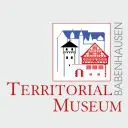Welcome to the virtual world of the Territorial Museum. We have visualized all rooms for you in 360 °.
A short explanation: You can zoom in and out, rotate and look up or down in the individual 360 ° images.
Some pictures have small black window symbols. Clicking on these symbols will take you to the next photo of the same room (tour).
Now have fun with the pictures.
Dachgeschoss
19. and 20th century
- The Babenhausen Territorial Museum is the starting and ending point of the Kunststoffstraße in the Darmstadt-Dieburg district. The production of the Cellba (Celluloid Babenhausen), which was the second largest doll factory in the German Empire before the Second World War, is highlighted.
- A lifelike replica of the robber Holzlips, who often stayed at the brickworks not far from Sickenhofen after his raids, is on display. A real guiding sword completes the representation. Clothes and mirrors encourage young and old visitors to dress up.
- Industrialization, railway construction, companies from Babenhausen and military history from the Red Dragoons to the American garrison provide an overview of two centuries. Numerous audio stations complement text and images.
- Several steals, some also with audio stations, tell of famous personalities and their relationships with Babenhausen.
Obergeschoss
The central hallway
Blue room
- Original column capital from the castle from 1189.
- Oil painting of Frederick II of Hessen-Kasell, who had the soldiers “sold” to America also collected in Babenhausen.
- On the life of the Gayling von Altheim family.
- View of the castle around 1780 (oil painting by Anton Wilhelm Tischbein)
Bright red room
- Bouxwiller (Buchsweiler) and Babenhausen.
- The Counts of Hanau-Lichtenberg
- The castle residents
- Hunting rag with moor and coat of arms
Dark green room
- City and country in the Middle Ages
- Witch hunt
- Gold guilders minted in Babenhausen
- Oldest surviving map of the area around Babenhausen
Wine red room
- Church history: Christopher without a head from the pre-Reformation period
- Church tower clock from Harreshausen
- Information about Erasmus Alberus as the first Reformation pastor in Babenhausen
- Thirty Years’ War
- Cannonball from the Hanauer Tor
Hochparterre
Lecture room
The lecture room is used all year round for numerous events. Here you can also find special exhibitions and the cash desk. The library, the kitchenette and the toilets are also located on this floor.
The lecture room can also be rented free of charge to cultural associations.
Souterrain
Prehistory and early history
Presentation of the prehistory and early history through finds and archaeological excavations.
After a brief look at the Roman times, the extraction of iron is documented. In the middle of the room a barrow is re-enacted. The well-preserved original can be viewed in the Harreshausen forest. There are two listening stations in the basement: an archaeologist speaks and a student who was present during excavations in 1978.
Cooking a digital soup and a film about urn burials from the Bronze Age complete the information.
Here you can also find the special exhibition on thermal insulation in the Bronze Age.
Aussenbereich
Lapidary
The lapidarium is a collection of stone works, such as grave slabs or gravestones, but also boundary and marker stones. The beautifully designed facility in the courtyard of the museum enriches the museum and at the same time links the exhibitions with other Babenhausen sights. After visiting the museum with the former tombstones from the town church, a visit to the church is just as obvious as going to the museum if you have visited the church.
Barrow in Harreshausen
The barrow can be reached from two sides: once via Babenhausen, coming from the Wichtelwald day care center via Rennweg. After the level crossing, turn left after about 200m.
Or via the extension of Gersprenzstrasse in Harreshausen. From here it goes straight to the edge of the forest. At the edge of the forest (parking lot) you walk left into the forest (Rennweg), from here it’s about 300m, then right.
In front of the grave is the information board showing the cross-section of a barrow with the grave goods from that time. If you look through the peephole on the board, the picture on the board is embedded in the landscape exactly at the location of the grave.
In the late Bronze Age, around 1200 to 800 BC, the barrows of Harreshausen were built. They are located on an ancient connecting road, the “Rennweg”. Around ten burial mounds from the Celtic era lie in the forest here. For the ignorant, however, they are difficult to make out because they hardly stand out from the forest floor. In addition, trees and bushes grow on it. If you don’t know the exact location, you will hardly find the historical places of the Celts.



 ,
,